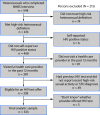Prevalence and Predictors of Provider-Initiated HIV Test Offers Among Heterosexual Persons at Increased Risk for Acquiring HIV Infection - Virginia, 2016
- PMID: 29953427
- PMCID: PMC6023187
- DOI: 10.15585/mmwr.mm6725a3
Prevalence and Predictors of Provider-Initiated HIV Test Offers Among Heterosexual Persons at Increased Risk for Acquiring HIV Infection - Virginia, 2016
Abstract
Since 2006, CDC has recommended routine, provider-initiated human immunodeficiency virus (HIV) screening (i.e., HIV screening at least once in lifetime) for all patients aged 13-64 years in all health care settings (1). Whereas evidence related to the frequency of HIV testing is available, less is known about the prevalence and predictors of providers' HIV test offers to patients (2). National HIV Behavioral Surveillance (NHBS) data from Virginia were used to examine the prevalence and predictors of provider-initiated HIV test offers to heterosexual adults aged 18-60 years at increased risk for HIV acquisition. In a sample of 333 persons who visited a health care provider in the 12 months before their NHBS interview, 194 (58%) reported not receiving an HIV test offer during that time, approximately one third of whom (71, 37%) also reported never having had an HIV test in their lifetime. In multivariable analysis, the prevalence of HIV test offers was significantly lower among men than among women (adjusted prevalence ratio [aPR] = 0.72; 95% confidence interval [CI] = 0.53-0.97). Provider-initiated HIV test offers are an important strategy for increasing HIV testing among heterosexual populations; there is a need for increased provider-initiated HIV screening among heterosexual adults who are at risk for acquiring HIV, especially men, who were less likely than women to be offered HIV screening in this study.
Conflict of interest statement
No conflicts of interest were reported.
Figures

References
-
- Branson BM, Handsfield HH, Lampe MA, et al. Revised recommendations for HIV testing of adults, adolescents, and pregnant women in health-care settings. MMWR Recomm Rep 2006;55(No. RR-14). - PubMed
-
- Sionean C, Le BC, Hageman K, et al.; NHBS study group. HIV Risk, prevention, and testing behaviors among heterosexuals at increased risk for HIV infection—National HIV Behavioral Surveillance System, 21 U.S. cities, 2010. MMWR Surveill Summ 2014;63. - PubMed
-
- CDC. Vital signs: HIV testing and diagnosis among adults—United States, 2001–2009. MMWR Morb Mortal Wkly Rep 2010;59:1550–5. - PubMed
MeSH terms
LinkOut - more resources
Full Text Sources
Other Literature Sources
Medical
Miscellaneous

